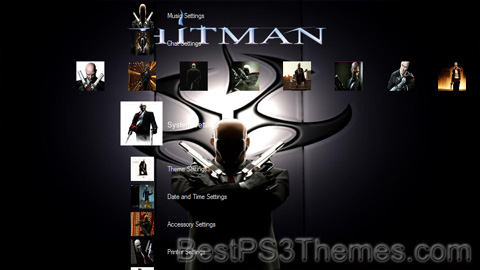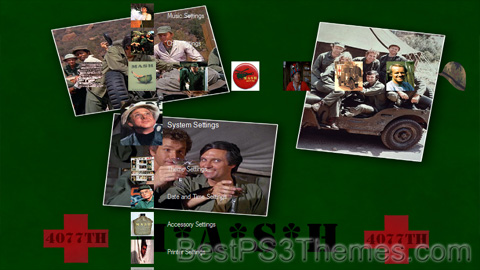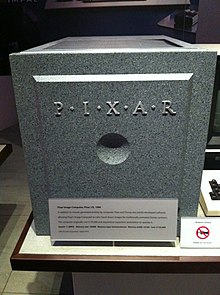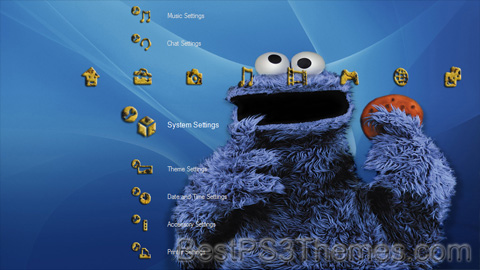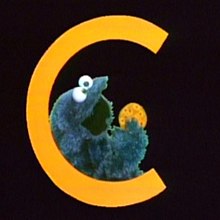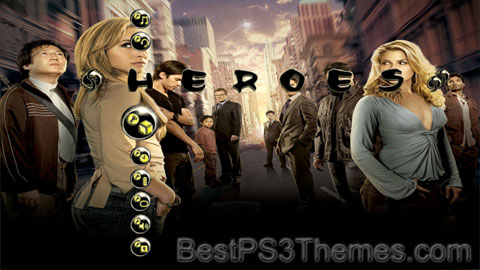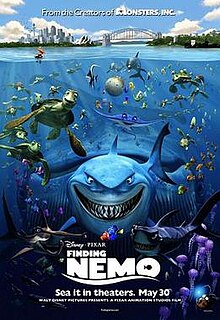South Park theme by Mc_Pee_Pants
Download: SouthPark.p3t
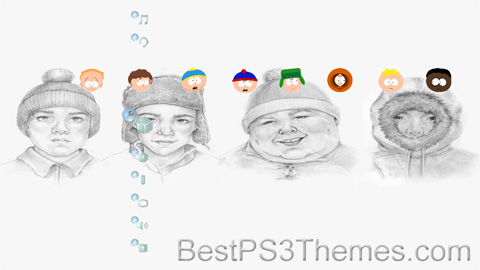
(2 backgrounds)
| South Park | |
|---|---|
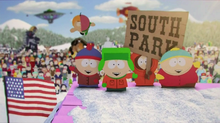 | |
| Genre | |
| Created by | |
| Developed by | Brian Graden |
| Showrunners |
|
| Voices of |
|
| Theme music composer | Primus |
| Composers |
|
| Country of origin | United States |
| Original language | English |
| No. of seasons | 26 |
| No. of episodes | 328 (list of episodes) |
| Production | |
| Executive producers |
|
| Producers |
|
| Cinematography | Kenny Gioseffi |
| Running time | 22 minutes[1] |
| Production companies |
|
| Original release | |
| Network | Comedy Central[nb 1] |
| Release | August 13, 1997 – present |
| Related | |
| The Spirit of Christmas | |
South Park is an American animated sitcom created by Trey Parker and Matt Stone and developed by Brian Graden for Comedy Central. The series revolves around four boys—Stan Marsh, Kyle Broflovski, Eric Cartman, and Kenny McCormick—and their exploits in and around the titular Colorado town. South Park also features many recurring characters. The series became infamous for its profanity and dark, surreal humor that satirizes a large range of subject matter.
Parker and Stone developed South Park from two animated short films, both titled The Spirit of Christmas, released in 1992 and 1995. The second short became one of the first Internet viral videos, leading to the series' production. The pilot episode was produced using cutout animation; the remainder of the series uses computer animation recalling the prior technique. Since the fourth season, episodes are generally written and produced during the week preceding its broadcast, with Parker serving as the lead writer and director.
Since its debut on August 13, 1997, 328 episodes of South Park have been broadcast. It debuted with great success, consistently earning the highest ratings of any basic cable program. Subsequent ratings have varied, but it remains one of Comedy Central's longest-running programs. In August 2021, South Park was renewed through 2027, and a series of television specials was announced for Paramount+, the first two of which were released later that year.[2][3] In October 2019, it was announced that WarnerMedia acquired exclusive streaming rights to South Park starting in June 2020 for HBO Max.[4] The series' twenty-sixth season premiered on February 8, 2023.[5]
South Park has received critical acclaim, and is included in various publications' lists of the greatest television shows. It has received numerous accolades, including five Primetime Emmy Awards and a Peabody Award. A theatrical film, South Park: Bigger, Longer & Uncut, was released in June 1999 to commercial and critical success, garnering an Academy Award nomination. In 2013, TV Guide ranked South Park the tenth Greatest TV Cartoon of All Time.[6]
Premise[edit]
Setting and characters[edit]
South Park centers around four boys: Stan Marsh, Kyle Broflovski, Eric Cartman and Kenny McCormick. The boys live in the fictional small town of South Park, located within the real-life South Park basin in the Rocky Mountains of central Colorado,[7] approximately a one-hour drive from Denver.[8] The town is also home to an assortment of other characters, including students, families, elementary school staff, and other various residents.[9] Prominent settings include South Park Elementary, various neighborhoods and the surrounding mountain range, actual Colorado landmarks, and the businesses along the town's main street, all of which are based on the appearance of similar locations in Fairplay, Colorado.[7][9] As one of the few television programs set in the Mountain West region that takes place outside the urban core of Denver, South Park frequently features the unique culture of the region, including cattle ranchers, Old West theme parks, snowy climates, mountaineering, Mormons, real-life Colorado locations such as Casa Bonita and Cave of the Winds, and many other regionally specific characteristics.
Stan is portrayed as an average American boy; however, he has many mishaps throughout the series. In the first 22 seasons, Stan lived in South Park, but in the episodes during and after season 22, Stan resided in Tegridy Farms. Kyle is Jewish, and his portrayal as one of the few such people in South Park is often dealt with satirically.[10] Stan is modeled after Parker, while Kyle is modeled after Stone. They are best friends, and their friendship, symbolically intended to reflect Parker and Stone's friendship,[11] is a common topic throughout the series. Cartman (as he is commonly referred to) is amoral and increasingly psychopathic, and is commonly portrayed as an antagonist. His staunch antisemitism has resulted in a progressive rivalry with Kyle.[10][12] Kenny, who comes from a poor family, tightly wears his parka hood to the point where it obscures most of his face and muffles his speech. During the first five seasons, Kenny died in almost every episode before reappearing in the next with no definite explanation. He was killed off in the fifth season episode "Kenny Dies", before being reintroduced in the sixth season finale, "Red Sleigh Down". Since then, Kenny is depicted as dying sporadically. During the first 58 episodes, the children were in the third grade. During the fourth season, they entered the fourth grade, where they have remained ever since.[13][14]
Plots are often set in motion by events, ranging from the fairly typical to the supernatural and extraordinary, which frequently happen in the town.[15] The boys often act as the voice of reason when these events cause panic or incongruous behavior among the adult populace, who are customarily depicted as irrational, gullible, and prone to overreaction.[7][16] They are frequently confused by the contradictory and hypocritical behavior of their parents and other adults, and often perceive them as having distorted views on morality and society.[9][17]
Themes and style[edit]
Each episode opens with a tongue-in-cheek all persons fictitious disclaimer: "All characters and events in this show—even those based on real people—are entirely fictional. All celebrity voices are impersonated.....poorly. The following program contains coarse language and due to its content it should not be viewed by anyone."[18][19]
South Park was the first weekly program to be rated TV-MA,[20] and is generally intended for adult audiences.[21][22][23] The boys and most other child characters use strong profanity, with only the most taboo words being bleeped during a typical broadcast.[9] Parker and Stone perceive this as the manner in which real-life small boys speak when they are alone.[24][25]
South Park commonly makes use of carnivalesque and absurdist techniques,[26] numerous running gags,[27][28] violence,[28][29] sexual content,[30][31] offhand pop-cultural references, and satirical portrayal of celebrities.[32]
Early episodes tended to be shock value-oriented and featured more slapstick-style humor.[33] While social satire had been used on the show occasionally earlier on, it became more prevalent as the series progressed, with the show retaining some of its focus on the boys' fondness of scatological humor in an attempt to remind adult viewers "what it was like to be eight years old".[10] Parker and Stone also began further developing other characters by giving them larger roles in certain storylines,[10] and began writing plots as parables based on religion, politics, and numerous other topics.[9] This provided the opportunity for the show to spoof both extreme sides of contentious issues,[34] while lampooning both liberal and conservative points of view.[9][16][35] Rebecca Raphael described the show as "an equal opportunity offender",[15] while Parker and Stone describe their main purpose as to "be funny" and "make people laugh",[36][37] while stating that no particular topic or group of people be exempt from mockery and satire.[16][32][38][39][40]
Parker and Stone insist that the show is still more about "kids being kids" and "what it's like to be in [elementary school] in America",[41] stating that the introduction of a more satirical element to the series was the result of the two adding more of a "moral center" to the show so that it would rely less on simply being crude and shocking in an attempt to maintain an audience.[36][37] While profane, Parker notes that there is still an "underlying sweetness" aspect to the child characters,[34] and Time described the boys as "sometimes cruel but with a core of innocence".[11] Usually, the boys or other characters pondered over what transpired during an episode and conveyed the important lesson taken from it with a short monologue. During earlier seasons, this speech commonly began with a variation of the phrase "You know, I've learned something today...".[42]
Development[edit]
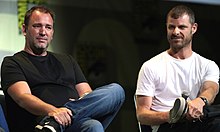
Parker and Stone met in film class at the University of Colorado in 1992 and discovered a shared love of Monty Python, which they often cite as one of their primary inspirations.[43] They created an animated short entitled The Spirit of Christmas.[27] The film was created by animating construction paper cutouts with stop motion, and features prototypes of the main characters of South Park, including a character resembling Cartman but named "Kenny", an unnamed character resembling what is today Kenny, and two near-identical unnamed characters who resemble Stan and Kyle. Fox Broadcasting Company executive and mutual friend Brian Graden commissioned Parker and Stone to create a second short film as a video Christmas card. Created in 1995, the second The Spirit of Christmas short resembled the style of the later series more closely.[44] To differentiate between the two homonymous shorts, the first short is often referred to as Jesus vs. Frosty, and the second short as Jesus vs. Santa. Graden sent copies of the video to several of his friends, and from there it was copied and distributed, including on the internet, where it became one of the first viral videos.[27][11]
As Jesus vs. Santa became more popular, Parker and Stone began talks of developing the short into a television series about four children residing in the fictional Colorado town of South Park. Fox eagerly agreed to meet with the duo about the show's premise, having prided itself on edgier products such as Cops, The Simpsons, and The X-Files. However, during the meeting at the Fox office in Century City, disagreements between the two creators and the network began to arise, mainly over the latter's refusal to air a show that included a supporting talking stool character named Mr. Hankey. Some executives at 20th Century Fox Television (which was to produce the series) agreed with its then-sister network's stance on Mr. Hankey and repeatedly requested Parker and Stone to remove the character in order for the show to proceed. Refusing to meet their demands, the duo cut ties with Fox and its sister companies all together and began shopping the series somewhere else.[45][46][47]
The two then entered negotiations with both MTV and Comedy Central. Parker preferred the show be produced by Comedy Central, fearing that MTV would turn it into a kids show.[48] When Comedy Central executive Doug Herzog watched the short, he commissioned for it to be developed into a series.[27][49] Parker and Stone assembled a small staff and spent three months creating the pilot episode "Cartman Gets an Anal Probe".[50] South Park was in danger of being canceled before it even aired when the show fared poorly with test audiences, particularly with women. However, the shorts were still gaining more popularity over the Internet, and Comedy Central ordered a run of six episodes.[36][48] South Park debuted with "Cartman Gets an Anal Probe" on August 13, 1997.[51]
Production[edit]
Except for the pilot episode, which was produced using cutout animation, all episodes of South Park are created with the use of software, primarily Autodesk Maya.[52] As opposed to the pilot, which took three months to complete,[53] and other animated sitcoms, which are traditionally hand-drawn by companies in South Korea in a process that takes roughly eight to nine months,[27][35] individual episodes of South Park take significantly less time to produce. Using computers as an animation method, the show's production staff were able to generate an episode in about three weeks during the first seasons.[54] Now, with a staff of about 70 people, episodes are typically completed in one week,[27][34][35] with some in as little as three to four days.[55][56][57] Nearly the entire production of an episode is accomplished within one set of offices, which were originally at a complex in Westwood, Los Angeles, California and are now part of South Park Studios in Culver City, California.[49][53] Parker and Stone have been the show's executive producers throughout its entire history.[58] Debbie Liebling, who was Senior Vice President of original programming and development for Comedy Central, also served as an executive producer during the show's first five seasons, coordinating the show's production efforts between South Park Studios and Comedy Central's headquarters in New York City.[59][60] During its early stages, finished episodes of South Park were hastily recorded to D-2 to be sent to Comedy Central for airing in just a few days' time.[61] Each episode used to cost $250,000.[62]
Writing[edit]

Scripts are not written before a season begins.[63] Production of an episode begins on a Thursday, with the show's writing consultants brainstorming with Parker and Stone. Former staff writers include Pam Brady, who has since written scripts for the films Hot Rod, Hamlet 2 and Team America: World Police (with Parker and Stone), and Nancy Pimental, who served as co-host of Win Ben Stein's Money and wrote the film The Sweetest Thing after her tenure with the show during its first three seasons.[64][65] Television producer and writer Norman Lear, an alleged idol of both Parker and Stone, served as a guest writing consultant for the season seven (2003) episodes "Cancelled" and "I'm a Little Bit Country".[63][66][67] During the 12th and 13th seasons, Saturday Night Live actor and writer Bill Hader served as a creative consultant and co-producer.[68][69][70]
After exchanging ideas, Parker will write a script, and from there the entire team of animators, editors, technicians, and sound engineers will each typically work 100–120 hours in the ensuing week.[50] Since the show's fourth season (2000), Parker has assumed most of the show's directorial duties, while Stone relinquished his share of the directing to focus on handling the coordination and business aspects of the production.[27][71] On Wednesday, a completed episode is sent to Comedy Central's headquarters via satellite uplink, sometimes just a few hours before its air time of 10 PM Eastern Time.[27][72]
Parker and Stone state that subjecting themselves to a one-week deadline creates more spontaneity amongst themselves in the creative process, which they feel results in a funnier show.[27] The schedule also allows South Park to both stay more topical and respond more quickly to specific current events than other satiric animated shows.[10][73] One of the earliest examples of this was in the season four (2000) episode "Quintuplets 2000", which references the United States Border Patrol's raid of a house during the Elián González affair, an event which occurred only four days before the episode originally aired.[74] The season nine (2005) episode "Best Friends Forever" references the Terri Schiavo case,[25][34] and originally aired in the midst of the controversy and less than 12 hours before she died.[35][75] A scene in the season seven (2003) finale "It's Christmas in Canada" references the discovery of dictator Saddam Hussein in a "spider hole" and his subsequent capture, which happened a mere three days prior to the episode airing.[76] The season 12 (2008) episode "About Last Night..." revolves around Barack Obama's victory in the 2008 presidential election, and aired less than 24 hours after Obama was declared the winner, using segments of dialogue from Obama's real victory speech.[77]
On October 16, 2013, the show failed to meet their production deadline for the first time ever, after a power outage on October 15 at the production studio prevented the episode, season 17's "Goth Kids 3: Dawn of the Posers", from being finished in time. The episode was rescheduled to air a week later on October 23, 2013.[78]
Animation[edit]
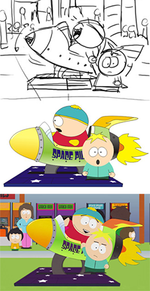
The show's style of animation is inspired by the paper cut-out cartoons made by Terry Gilliam for Monty Python's Flying Circus, of which Parker and Stone have been lifelong fans.[48][11][79] Construction paper and traditional stop motion cutout animation techniques were used in the original animated shorts and in the pilot episode. Subsequent episodes have been produced by computer animation, providing a similar look to the originals while requiring a fraction of the time to produce. Before computer artists begin animating an episode, a series of animatics drawn in Toon Boom are provided by the show's storyboard artists.[50][80]
The characters and objects are composed of simple geometrical shapes and primary and secondary colors. Most child characters are the same size and shape, and are distinguished by their clothing, hair and skin colors, and headwear.[17] Characters are mostly presented two-dimensionally and from only one angle. Their movements are animated in an intentionally jerky fashion, as they are purposely not offered the same free range of motion associated with hand-drawn characters.[10][53][81] Occasionally, some non-fictional characters are depicted with photographic cutouts of their actual head and face in lieu of a face reminiscent of the show's traditional style. Canadians on the show are often portrayed in an even more minimalist fashion; they have simple beady eyes, and the top halves of their heads simply flap up and down when the characters speak.[38]
When the show began using computers, the cardboard cutouts were scanned and re-drawn with CorelDRAW, then imported into PowerAnimator, which was used with SGI workstations to animate the characters.[50][53] The workstations were linked to a 54-processor render farm that could render 10 to 15 shots an hour.[50] Beginning with
Smurfs
Smurfs theme by Mc_Pee_Pants
Download: Smurfs.p3t
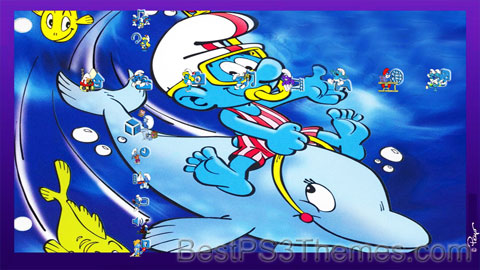
(2 backgrounds)
Redirect to:
This page is a redirect. The following categories are used to track and monitor this redirect:
|
Elite Squad
Elite Squad theme by -Venom-
Download: EliteSquad.p3t

(2 backgrounds)
| Elite Squad | |
|---|---|
 Theatrical release poster | |
| Directed by | José Padilha |
| Written by | Bráulio Mantovani José Padilha Rodrigo Pimentel |
| Based on | Elite da Tropa by André Batista Luiz Eduardo Soares Rodrigo Pimentel |
| Produced by | José Padilha Marcos Prado |
| Starring | Wagner Moura Caio Junqueira André Ramiro |
| Cinematography | Lula Carvalho |
| Edited by | Daniel Rezende |
| Music by | Pedro Bromfman |
Production company | Zazen Produções |
| Distributed by | Universal Pictures |
Release dates | August 17, 2007 (Rio de Janeiro) (premiere)[1]
|
Running time | 115 minutes |
| Country | Brazil |
| Language | Portuguese |
| Budget | R$ 11 million (US$ 8 million) |
| Box office | R$ 28 million (US$ 14.1 million)[2] |
Elite Squad (Portuguese: Tropa de Elite, pronounced [ˈtɾɔpɐ dʒi eˈlitʃi] lit. '"Elite Corps"') is a 2007 Brazilian crime film based on the novel Elite da Tropa by Luiz Eduardo Soares, André Batista, and Rodrigo Pimentel. Directed by José Padilha (from a screenplay by Padilha, Bráulio Mantovani, and Pimentel), the film stars Wagner Moura, Caio Junqueira, and André Ramiro, and tells the story of Roberto Nascimento (Moura), a captain with the Batalhão de Operações Policiais Especiais, or BOPE ("special police operations battalion"), who leads a police crackdown on a series of Rio de Janeiro favelas in-preparation for the Brazilian state visit of Pope John Paul II.
Inspired by the Military Police of Rio, and their related arms, Elite Squad is the second feature and first film by Padilha, after the documentary Bus 174 (2002).
Elite Squad was an overwhelming critical and commercial success, and became a cultural phenomenon in Brazil. The film won the Golden Bear at the 2008 Berlin Film Festival. Its sequel, Elite Squad: The Enemy Within, was released in Brazil on October 8, 2010, and holds industry records in the country for high ticket sales and gross revenue.
Plot[edit]
In 1997, Roberto Nascimento, a BOPE captain, leads an operation to secure the Turano neighbourhood before Pope John Paul II's overnight visit at the Archbishop's home near the favela. With his wife Rosane pregnant, Roberto searches for a successor at the unit before switching to a desk job.
Rookie PMERJ officers and best friends André Matias and Neto Gouveia handle menial work as instructed to them by their corrupt seniors: Neto supervises the police auto mechanic shop, whilst Matias is responsible for registering and filing police complaints in a small archive office. André also attends law school, where he begins a relationship with Maria, and meets her friends Roberta and Edu; all three are members of a NGO that operates in an area ruled by drug lord Baiano. Baiano provides marijuana to Matias' friends, who sell it on campus. André also befriends Romerito, a boy who, like himself, suffers from myopia.
Neto applies to another department, but his transfer is denied. Disgusted by corruption and led by fellow officer Fábio, Neto and André steal the police's bribe money to fix as many police cars as possible. Their superior, Captain Oliveira, finds out and demotes them to kitchen work as punishment and orders Fábio—whom he believes stole from him—to meet drug traffickers at a community funk party in Morro da Babilônia to enquire about payment.
Fábio realizes this is a set-up to kill him and discreetly warns Neto and André, who rush to a vantage point at the party. They use a sniper rifle telescope to watch Oliveira and other policemen but Neto accidentally shoots, causing a deadly gunfight between the officers and traffickers; as André and Neto attempt to flee the scene, Roberto and his men rescue all the officers. After the shootout, André is photographed by the press. André and Neto apply for BOPE, motivated by their honesty and devotion, and eagerness for action. At the NGO office, Baiano confronts Maria and her friends with a newspaper featuring André's picture and threatens to kill them if they bring policemen inside his territory.
BOPE training proves to be gruesome, with many candidates quitting the program, including Fábio (who applied as a way to avoid Oliveira), but both Neto and André pass; Neto celebrates by getting a BOPE tattoo on his arm. André's relationship with Maria ends and he confronts Edu, ordering him to arrange a meet with Romerito the next day to give him a pair of glasses. Edu reveals André's plan to Baiano, who sets an ambush to kill him. Neto informs André of a job interview at a law firm that will conflict with meeting Romerito, and volunteers to deliver the glasses in his place: this results in Neto being mortally wounded. When Baiano prepares to execute him, he notices his BOPE tattoo and goes into hiding for fear of retaliation.
After Neto's funeral, André, Roberto, and the men make daily incursions into Baiano's slum, torturing several dealers into revealing his whereabouts. After one of them reveals Edu tipped Baiano, Matias storms into a peace walk, beats Edu, and insults Maria and the others. BOPE locate and corner Baiano: Roberto orders André to shoot Baiano in the face with a shotgun, as revenge for Neto's death and his final test for BOPE. As Baiano pleads, André cocks the gun and the screen fades to white as a shot is heard.
Cast[edit]
- Wagner Moura as Roberto Nascimento - A captain in the BOPE squad, who is awaiting a promotion that will make his job safer and enable him to spend time with his wife and newborn son. In order to move into his new position he needs to find a worthy successor.
- Caio Junqueira as Aspirant Neto Gouveia - He is a rookie police officer and Matias' best friend. Nascimento describes Neto as being similar to himself when he was younger. He is a tough man, but has a fierce temper as well, and never gives up on his mission. He later joined BOPE to seek out justice and was groomed for Nascimento's spot.
- André Ramiro as Aspirant André Matias - Another rookie police officer, he is also a law student, who wants to specialize in criminal law. He is a resourceful and calculating tactician. He joins BOPE along with Neto Gouveia.
- Maria Ribeiro as Rosane Nascimento - Nascimento's wife. They are expecting their first child. She dislikes Nascimento's frequent absence from home and the dangers associated with his job.
- Milhem Cortaz as Capitão Fábio Barbosa - One of the captains where Matias and Neto work he develops a sort-of friendship with the two. A former pimp in Copacabana he also runs a protection racket scheme. After Matias and Neto stole the drug payoff he feared that Oliveira would blame him and have him killed.
- Fernanda Machado as Maria - A law student and founding member of the NGO, she is also a marijuana user. She befriends Matias and falls in love with him, but when Baiano finds out that he is a cop, she abandons him for lying to her and because she fears Baiano's retribution. She later helps Matias by giving him the name of Baiano's girlfriend. In the end, Matias insults her and her friends and walks away, ending their relationship.
- André Di Mauro as Pedro Rodrigues - A student who works in the favela's NGO and dates Roberta. As a punishment for bringing a cop into the drug dealer's circle of friends, Rodrigues is necklaced.[3]
- Paulo Vilela as Edu - Nicknamed "Playboy", he is the main university drug dealer and is close to Baiano, although he is afraid of him. He despises Matias for his defense of police officers.
- Fábio Lago as Baiano - He is a ruthless drug lord who sells marijuana and heroin throughout the university using several students. Unlike many other drug lords, he hates all cops, even the corrupted ones, and avoids having business with them. Edu is his main seller on the university. He has a small auxiliary that protects the NGO.
- Marcelo Valle as Capitão Oliveira - He is Fabio's rival and superior in the police force, taking over his territory for protection rackets and later allegedly setting him up to be killed.
- Fernanda de Freitas as Roberta Alunde
- Alex Avellar, as 02
- Ricardo Pagotto Piai, as 08
- Guilherme Aguilar, as 07
- Pedro Bonfim, as PM Robson
Inspiration[edit]
The movie is based on Elite da Tropa,[4] a book by two BOPE policemen (Batalhão de Operações Policiais Especiais - Rio de Janeiro military police squads for special actions), André Batista and Rodrigo Pimentel, together with sociologist & anthropologist Luiz Eduardo Soares, which provided a semi-fictional account of the daily routine of the BOPE as well as some historical events, based on the experiences of the two BOPE policemen. The book was controversial at the time of release, in its description of the BOPE as a "killing machine", as well as the detailed allegation of an aborted assassination attempt on then left-wing governor of Rio de Janeiro, Leonel Brizola, and reportedly resulted in Batista being reprimanded and censured by the Military Police. The writing contained some discrepancies, however Soares did not retract his novel.[5] The novel had a unique reception when it was translated in 2010. There were many fans of the original novel and film who felt that the Portuguese-English translation was poor and did not follow the film and vice versa. Ultimately the novel (before translation) was more like the film than the novel in English.[citation needed]
Production leak[edit]
In August 2007, prior to the movie's release to theaters, a preliminary cut of the film was leaked and made available for download on the Internet. The cut, which included English title cards but no subtitles, was leaked from the company responsible for subtitling the film, resulting in one person being fired and a criminal investigation. It was estimated that about 11.5 million people had seen the leaked version of the movie in 2007.[6]
Reception[edit]
Popularity and box office[edit]
Tropa de Elite became one of the most popular Brazilian movies in history. According to Datafolha, 77% of São Paulo residents knew about the movie. The word of mouth was also important for the disclosure of the film, with 80% of the people rating the movie as "excellent" or "good", according to the same poll.[7] The movie was released in Rio de Janeiro and São Paulo on October 5, 2007 (with the intention of being considered by the Ministry of Culture to compete as the Brazilian entry for the Best Foreign Language Film Oscar). It was released nationwide on October 12, 2007. By January 2008, 2.5 million people had seen it in theaters.[8] In Rio and São Paulo, with no promotion other than billboards, 180,000 people saw the movie during its opening weekend.[7][9]
The movie was also the cover issue for the two Brazil's most important weekly magazines, Veja and Época. In the beginning of 2008 it was confirmed that Rede Globo would produce a TV series based on the movie.[10] In 2011 Rockstar Games recommended Elite Squad to fans of its video game Max Payne 3,[11] which is set in Brazil and depicts battles between special police units and favela gangs.
Critical response[edit]
Outside Brazil reviews of the film were initially mixed, but after time the film was received more positively. Elite Squad has an approval rating of 51% on review aggregator website Rotten Tomatoes, based on 35 reviews, and an average rating of 5.2/10. The website's critical consensus states: "Brutal, action-heavy Brazilian cop film with a pointless voiceover. Lacks flair, overdoes the violence and is never quite sure where its morals lie".[12] Metacritic assigned the film a weighted average score of 33 out of 100, based on 6 critics, indicating "generally unfavorable reviews".[13]
Criticism[edit]
When the first version of the film leaked, it caused a major controversy for its portrayal of Captain Nascimento's unpunished police brutality in slums (favelas); some saw it as glamourizing police violence. After its exhibition in Berlin Film Festival, critic Jay Weissberg, in a Variety article, called the movie "a one-note celebration of violence-for-good that plays like a recruitment film for fascist thugs".[14] Michel Misse, a researcher of urban violence in the Federal University of Rio de Janeiro, in an article by Carta Capital, tried to explain why some people cheered at Captain Nascimento's actions: "as the judiciary system cannot keep up with the demand for punishment, some may think civil rights leads to unpunishment. And then, they want illegal solutions. That's why Captain Nascimento is called".[15]
Awards[edit]
On February 16, 2008, Elite Squad won the Best Movie award of the Berlin International Film Festival, the Golden Bear.[16]
Soundtrack[edit]
The soundtrack of the film was a collection of popular hits, but even the soundtrack would not escape controversy as the Brazilian authorities demanded the removal of MC Leonardo's "Rap das Armas" from the film, because of alleged promotion of violence like use of illegal arms and drugs. The filmmakers complied two weeks after the official release.
- "Rap das Armas" - Bateria da Rocinha, MC Junior & MC Leonardo
- "Tropa de Elite" - Tihuana
- "Rap da Felicidade" - MC Cidinho, MC Doca
- "Passa Que é Teu" - Pedro Bromfman
- "Brilhar a Minha Estrela" - Sangue da Cidade
- "Kátia Flávia, a Godiva do Irajá" - Fausto Fawcett
- "Teatro de Bonecos" - Guilherme Flarys, Pedro Guedes
- "Polícia" - Titãs
- "Invasão do BOPE" - Pedro Bromfman
- "Lado B Lado A" - O Rappa
- "Andando Pela África" - Barbatuques
- "Nossa Bandeira" - Bateria da Rocinha, MC Leonard
- "Rap das Armas [Funk]" - MC Leonard
Sequel[edit]
A sequel, named Tropa de Elite 2: O Inimigo Agora É Outro, was released in Brazil on October 8, 2010, and in the U.S. on November 11, 2011.
See also[edit]
References[edit]
- ^ "Tropa de Elite Release Info". IMDB. Retrieved 29 July 2022.
- ^ "Elite Squad (2008)". Box Office Mojo.
- ^ "Tropa de Elite". ZAZEN PRODUÇÕES. Retrieved 9 September 2017.
- ^ "IPS – BRAZIL: Book Takes Dark Journey into World of Police Corruption | Inter Press Service". Ipsnews.net. 2006-07-27. Retrieved 2013-11-17.
- ^ Monken, Mario Hugo. Livro sobre elite da PM do Rio causou punição, diz autor. Folha de S.Paulo. April 29, 2006. Retrieved on September 5, 2007.
- ^ Marcelo Cajueiro (2007-10-19). "'Elite' stirs controversy, box office". Variety. Retrieved 2013-11-17.
- ^ a b Datafolha (October 6, 2007). ""Tropa de Elite" já foi visto por 19% dos paulistanos". Folha de S.Paulo.
- ^ Ag. Estado (January 11, 2008). "'Tropa de Elite' pode render doações". Agência Estado. Archived from the original on 2008-01-15.
- ^ "Página não encontrada - iG". Ultimosegundo.ig.com.br. Archived from the original on 2012-03-28. Retrieved 2013-11-17.
- ^ "Folha Online - Ilustrada - Globo vence Record e leva "Tropa de Elite", informa Daniel Castro". .folha.uol.com.br. 2008-02-18. Retrieved 2013-11-17.
- ^ "Rockstar Recommends: "Elite Squad (Tropa de Elite)"". Rockstar Games. 2011-11-10. Retrieved December 12, 2012.
- ^ "Tropa de Elite (The Elite Squad)". Rottentomatoes.com. Retrieved 9 September 2017.
- ^ "Elite Squad". Metacritic.
- ^ Weissberg, Jay. "The Elite Squad Review", Variety, February 11, 2008. Accessed May 8, 2009. Archived February 17, 2013, at archive.today
- ^ Sousa, Ana Paula. "Herói torturador"[permanent dead link], CartaCapital. Accessed May 8, 2009.
- ^ Collett, Mike (2008-02-16). "Violent Brazil cop drama named best film in Berlin". Reuters. Retrieved 2013-11-17.


